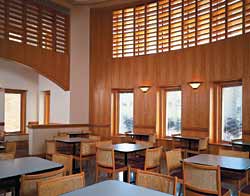Greater Vision: Alternate Window Materials in Commercial Buildings
Durability
When determining a structure's windows, consider the building owner's or developer's intent for the project. How long do they expect the building to last? How well will the owner maintain the structure? How will weather conditions affect the structure?
The durability of any material can be proven by how it reacts over time to weather extremes, impact and damage caused by nature or human acts. The thermal break of a window also is a key consideration in durability.
With wood windows, a thermal break is natural because of wood's inherent properties, making it a more stable option. But the durability of wood is sometimes misunderstood because in certain climates it can be more susceptible to rot. According to the Window and Door Manufacturers Association (WDMA): "Wood stands the test of time. It doesn't naturally decay as many people believe and indeed has been found nicely preserved in 2,000-year-old structures."
Wood-frame windows on historic buildings have lasted for centuries-a testimony to wood's incredible durability. Prior to the 1920s, wood was virtually the only window frame material available. Today, the most common reasons to replace wood-frame windows are not because of structural or material failure, but rather to:
- Replace single glazing with more efficient dual glazing;
- Improve weatherstripping to reduce air infiltration; or
- Provide exterior aluminum cladding to eliminate exterior repainting.
Aluminum windows are perceived as highly durable. The only weakness is in the construction of the thermal break, which is commonly engineered using a polyurethane material that is susceptible to shrinking and cracking over time. This can eventually cause glazing failure, increased air and water leakage, and a general degradation of the window unit's structural integrity.
Architects concerned about thermal break performance can reference the test method and performance requirements outlined in The American Architectural Manufacturers Association (AAMA) publication 505-98, "Dry Shrinkage and Composite Performance Thermal Cycling Test Procedure".
Vinyl resists abrasion and moisture and withstands rust and corrosion, but generally is less durable than other window frame materials. According to the WDMA, however, efforts have been made to make vinyl a more long-lasting material. The WDMA Hallmark Certification program focuses on stabilizing manufacturers' formulation compounds by requiring long-term weathering tests for color retention and certain mechanical properties. This has helped upgrade the quality of vinyl and reduce the number of manufacturers making less-than-quality vinyl material.
|
Fiberglass is a strong and durable window frame material. It is nine times stronger than vinyl and twice as strong as aluminum in tensile strength. It also offers high impact and scratch resistance and low thermal expansion.










